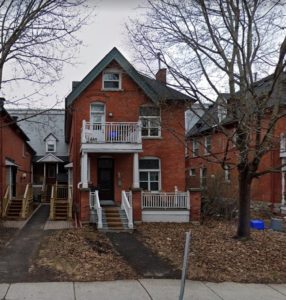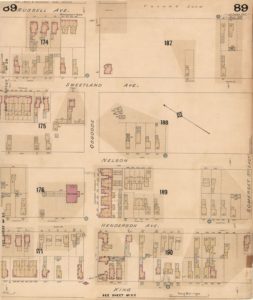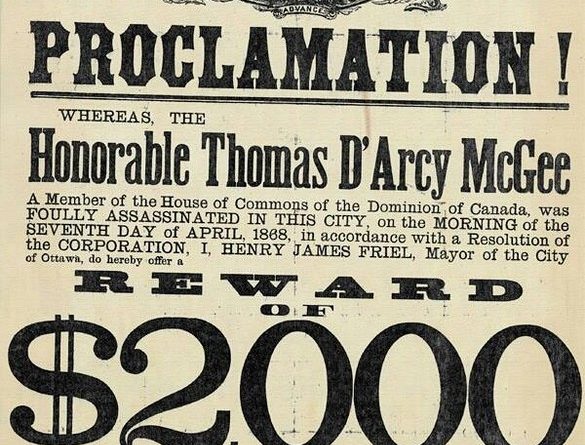Ken Clavette’s Album of Bygone Sandy Hill
Alexander S. Woodburn
Printer, founder of the Ottawa Journal, Sandy Hill resident
Ken Clavette

Alexander Smith Woodburn was a prominent citizen in early Ottawa. He rented a home at 332 Besserer St. before buying a house at 46 Henderson Ave. (now numbered 40) in 1898 and where he died in 1904.
Born Nov 13, 1830 in Garvagh, County Derry, Ireland, he immigrated with his parents and four siblings to Hull Township in 1841. The family moved a short time later to Gloucester Township where his father farmed near Green’s Creek. “A.S,” or “Alex” left the farming life to work in Ottawa in his teens. Taking up the printing trade he apprenticed under Dawson Ker, publisher of the Orange Lily; then as a journeyman, he was the foreman of the Bytown Gazette. In 1862 he married Hannah Mills and together they had six children, four girls and two boys.
Along with a partner, John George Bell, he established a printing business in the 1860s working together until Bell’s death in 1874. Their business prospered and at one point employed up to 80 people. When Thomas D’Arcy McGee was assassinated on April 7, 1868, it was Bell & Woodburn that printed up the reward poster that offered the princely sum of $2,000. The firm printed the City Directory, along with maps, and government documents. The offices were at 36 Elgin and his home just around the corner at 127 Maria (now Laurier Ave West).
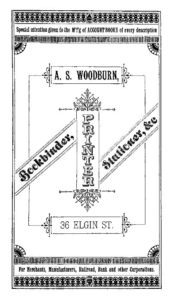
His early work in newspapers led him to found the Ottawa Evening Journal which appeared on the streets of the capital on Dec. 19, 1885. Starting a newspaper is expensive, and facing financial difficulties with both the printing business and the newspaper, the next year Woodburn brought in a partner, Philip Dansken Ross, to whom he sold his share in the Journal in 1891.
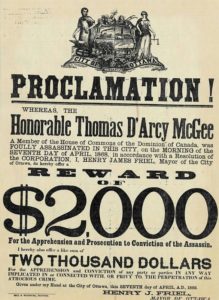
In 1871 Woodburn served on City Council representing Wellington Ward for only one annual term. In his obituary the Journal wrote, “never again did he show any ambition to re-enter the municipal arena devoting his attention more to philanthropic work.” And serve his community he did. He was secretary-treasurer of the County of Carleton Exhibition Association and helped to promote the large exhibitions, forerunners of the Central Canada Exhibition or the “Super Ex” as it was finally known. In that role in 1875 he successfully lobbied to have Elgin Street, which then stopped at Lisgar, extended out to Lansdowne Park.
A teetotaler, he was an active organizer of the Sons of Temperance Lodge in Ottawa. A founder of the Irish Protestant Benevolent Society, he helped found the Protestant Home for the Aged (now known as the Glebe Centre) eventually making it non-denominational. He was on the board of directors of the Ladies’ College (Carleton University’s first home in the Glebe). He also served on the board of the County of Carleton Protestant General Hospital located in what became known as Wallis House on the corner of Rideau and Charlotte streets. He and Hannah attended the founding meeting of the Lady Stanley Institute for Trained Nurses in 1890, Ottawa’s first nursing school.
In his early years he became interested in military affairs because of an 1855 decision by the British Government to withdraw most of its troops from the Province of Canada. The colonial legislative assembly passed the passed the Militia Act which included the creation of the Volunteer Militia Field Battery of Ottawa which Woodburn helped organize. The Regiment became known by the nickname, “The Bytown Gunners” and is now known as the 30th Field Artillery Regiment, one of the country’s oldest military units. Woodburn served with the battery along the Canadian border in eastern Ontario 1866 and 1870 in response to potential Fenian raids from the United States. He acted as the unit’s paymaster and retired with the rank of Honorary Major.
In 1892 Woodburn gave up his printing businesses due to financial strain and personal tragedy. Both his sons died young, Robert in 1871 at the age of eight, and in 1883 Sydney, who Woodburn was bringing into the business with hopes he would succeed him. He had lost his government contract due to political patronage after investing in a larger printing plant. While he fought a protracted legal battle, finally winning $18,600 in damages, by then most of the money went to pay his creditors. To earn a living, he returned to the Journal as an employee in their printing business.
Woodburn died on March 31, 1904 and was laid to rest at Beechwood Cemetery. The Ottawa Journal wrote about him, “His name has been always associated with the growth and progress of the city.” It said, “We are sure he will be missed and regretted in the business world of this city, where he was to the last a familiar figure, very specially regretted in the circles which were familiar with his philanthropic work.”
A small collection of Woodburn’s documents are now in Library and Archives Canada that tell the history of Ottawa’s early years, and of the organizations he was involved in.
His name is associated with the growth of the city but sadly even when the City of Ottawa did its Sandy Hill Heritage Study in 2010 not a mention was made of this man who built and served our city, lived and died here in his Sandy Hill home. He was indeed a community activist that shaped our city and one we should remember.
